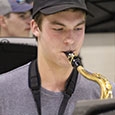Wind Symphony, Mason, Ohio
Directed by Edward F. Protzman
The Program and Community
Mason has grown a lot in the last 20 years. It is a very supportive community. Before I came to the school, I attended two performances by their groups at Midwest in 2004 and 2016 and really admired the program. The marching band also has a great history of making Grand National Finals one year. When an opportunity to lead the program came up, I threw my hat in the ring and was fortunate enough to get the position. I felt honored to join a program with such a great history, just a big program with lots of success. We came out of COVID with a really strong group of players, and the director team decided to submit an audition recording for Midwest. In preparation for that, we worked with some of our musical mentors, including Richard Floyd and James Keene, both of whom were supposed to guest conduct on our concert. (Unfortunately, James Keene passed away this summer, a sad moment for us.) We also worked a lot with Freddy Martin. We knew the timing was right, so we auditioned and were accepted. It is my first time taking a group to Midwest and the third for the program.
Preparing
While planning our rehearsals for Midwest, I worried about how busy the marching band gets in October and November with Grand Nationals and BOA regionals. I gave students a summer assignment to learn the hardest piece on our Midwest program. Each player sent me several recordings over the summer, and that gave us a great start. When school began, we had already learned our Grade 6 piece. About every other week, we have an extra afterschool rehearsal on Wednesdays, the day our marching band does not rehearse. So, we have had some extra rehearsals but not a significant amount. I had to pick literature carefully to fit this group of students so when it gets really busy with Grand Nationals, we can still get a lot accomplished.
The Role of Marching in the Program
Because marching is so high profile here, it draws students into the program. Once they join, we work to elevate their interest and enthusiasm for playing in great concert ensembles. The program has five concert bands, so players have a chance to work their way up. At Mason it is a synergistic relationship, and we don’t treat one type of ensemble as more important than the other. We try to do both well. We also make sure that our teaching techniques are consistent across the ensembles. When students are in marching band, they are still developing their concert skills because we are not teaching different philosophies.
Our high school is quite large at 3,600 students, but there is still a small-town feel downtown. There are two local parades, and the town loves having us perform for these. We also have a really diverse community because there are a couple of big corporations in town. We have all of these great influences, and everybody works well together. It is a unique, dynamic place where the arts are well supported.
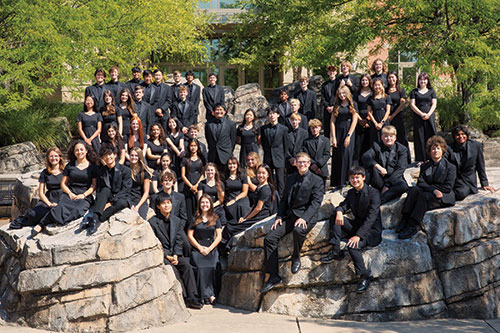
Greatest Strengths of Mason Bands
Our tone and sound are real strengths and a primary focus of our work on fundamentals throughout the program. We constantly seek that great characteristic darker sound. Developing an understanding of how a great professional flute or trumpet sounds is essential. We emphasize that quite often, especially in the lower classes.
Our classes average about 70 minutes, and 30 minutes of all our of classes from lowest to highest are spent on fundamentals. In the top ensemble, we listen to professionals play solos because it is a great way to teach musicality. We are fortunate to have multiple band directors and can spend considerable time in sectionals.
We are lucky to have private teachers to give lessons in the building, and we try to select players who offer students a great sound model. We do a lot of singing and solfeggio in the upper groups and find that internalizing that sound is helpful. Even if students don’t have it right away, they know what it is and can work towards it.
Pandemic Lessons
We implemented many things during COVID that have stuck with the program. Students made frequent recordings for us to document their work during that time, and we have kept that approach. Often the upper group will have a recording due prior to rehearsing a piece. This prepares them to work on it right away. We have also been reminded to value every minute we have in the classroom with the students because it is not guaranteed.
Special Pieces on the Midwest Program
Composer Onsby Rose has written a commission dedicated to my father, who was a musician and passed away a while ago. It is a wonderful piece that will close our concert. We also chose a really beautiful piece called Safely Rest by Ohio-based composer Nicole Piunno. She didn’t compose it for us, but it is a wonderful newer piece that combines Amazing Grace and Taps. Richard Floyd is going to conduct that. The kids really love this piece.
Our soloist is saxophone professor James Bunte from the University of Cincinnati College-Conservatory of Music. We are playing a piece by John Williams from the movie Catch Me If You Can that is really fun and jazzy. It is called Escapades for Alto Saxophone and Concert Band, and we are doing the 3rd movement, Joyride, which is bright, happy, and different from most concertos.
Decision to Direct
When I was an undergraduate, I was hoping to be an orchestral percussionist. I had the pleasure of working with Willis Rapp, an amazing educator and percussionist, who changed my mind and made me want to become a band director. Once Will worked with me as a mentor, I never looked back.
Early Teaching Lessons
When I started out, my first directing job was at a program where the previous director had been there for 30 years. He was an incredible but stern director, so in my early days as a conductor, I thought I had to control everything. The older I get, the more I realize that contributions from students and other staff members are what make a program educationally sound and vibrant.
My biggest recommendation to younger directors is to find great mentors. I have been so lucky to fall into situations where different people have worked with my programs and helped me learn. For the last six years at Mason, Cheryl and Richard Floyd have come in every year to work with our bands, and Richard has become one of my biggest musical influences. It is so rewarding that he will be conducting on our concert.
My First Visit to Midwest
The first time I went, it really blew my mind. I remember going in to hear the concerts and thinking, “Oh my gosh, I don’t know how to get my band to sound like this. I probably will never be in a program that plays at this level.” That was the start of my journey, and I have been back almost every year. As I have learned and figured out what is going on, taking my group to Midwest started to seem possible. Midwest has been a huge factor in my growth and development.
Choosing Great Music
Repertoire is really important to me. I was lucky enough to complete an Artist’s Diploma at the University of Calgary. They used to have this summers-only masters program, and we had many great visitors. Frank Battisti was the first person I heard talk about the value of high-quality music. It is not necessarily that I want students to play certain pieces, but I work hard to make sure that anything we invest time in has a deeper meaning or historical background that we can teach and players can grasp.
Four years ago at the National Concert Band Festival, we played Music for Prague 1968 by Karel Husa, and I wasn’t sure if students would buy into it. They loved the history of it and learning about what was happening in Europe at the time. When we do a piece, we try to find something where we can teach a little bit more about it. For our big piece at Midwest, we are performing Paul Dooley’s Masks and Machines, which is based on Bauhaus art combined with Renaissance music, and we discussed those aspects in class. I try to make sure that they are exposed to Grainger and Holst, but band music has taken such a turn in the last 20 years. There are some incredible new composers out there. We really vet everything we play to make sure it is a high-quality piece of music.
Borrowed Ideas
I definitely have stolen many of Richard Floyd’s catchphrases; he has so many important ones. We often repeat his statement that “Bands that breathe together play together.” That seems so simple, but it is true. If the first note isn’t great, it can almost not matter what comes next.
We also used ideas from Freddy Martin in our teaching. His advice is to achieve consistency in everything you do. He says “The difference in groups is the groups that never, the groups that sometimes, and the groups that always.” Groups that never play with good support, groups that sometimes play with good support, and groups that always play with good support. We have that posted in our rehearsal room. You can apply that to just about any area of music.
Unforgettable Memories
I am amazed at the quality and maturity of our students. They have never complained about extra rehearsals or playing tests. They understand what we are trying to do, and their love for music carries them through any difficulties.
The most memorable moment in our preparations for Midwest happened when Richard Floyd was here conducting, and Nicole Piunno was here for her composition. It was so stimulating to have a conductor and a composer in the room at the same time. We decided early on and put in writing that the most important thing about the Midwest trip was going to be their experience. We haven’t let the grind of trying to play something perfectly or having the most incredible-sounding band get in the way of that. We are focusing on students having an amazing experience throughout the process.
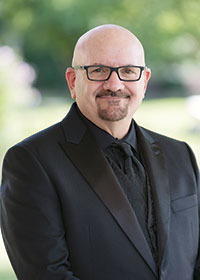
Edward F. Protzman is Director of Bands at William Mason High School in Ohio. His ensembles have been selected to perform at music conferences in Ohio, Kansas, and Pennsylvania, and at the Music for All National Concert Band Festival. He earned degrees from Moravian College and Kutztown University (both in Pennsylvania) and a Graduate Diploma in Wind Conducting from the University of Calgary in Alberta, Canada. He is a candidate for the Doctorate of Music Education degree at Liberty University in Virginia.
Carrollton, Texas
Directed by Kim Hawbaker-Cooley
The Program
Creek Valley Middle School has 570 students with close to 190 kids in two performing bands and a beginner band. The surrounding community is very diverse and fairly middle class. There are lots of challenges on our campus, but at the same time we have really good kids. Everyone is very supportive of the band program, so I am fortunate.
Returning to Midwest
We were invited to Midwest in 2016 with the Creek Valley Honor Winds, and I thought we should keep prepping for opportunities like this. I applied for 2022, and we were lucky to be picked. I keep trying to explain to students the magnitude of this, but right now they are just middle school kids who are excited about a trip to Chicago and having fun with their friends.
Carol Brittin-Chambers came out and worked with the group. They all got her autograph, so that was one glimpse that this is something different. We are going to have William Owens out to work on his piece as well. We just finished with Region and District auditions, so as the Midwest gets closer, the reality will start setting in.
When we went in 2016, I will never forget the receiving line after the concert. People were so genuinely nice. I was overwhelmed by that. The level of support for my kids, and the kind words were amazing.
Pieces on the Concert
With all of my programming, especially both times at Midwest, I try to reach out to everyone with the music. I have some old, some new, some angry, some happy, something for everyone in the audience. I am particularly excited about a commission by Eric Rath. I went to West Texas A&M with Eric and know him really well. When Hebron High School (the school my students feed into) went to Midwest in 2010, he wrote Oracle for them. That composition was a big hit, and he has always wanted to do a middle school version. Soothsayer is his vision of a sequel to Oracle.
A Career Turning Point
I didn’t realize I wanted to be a band director until my third year of college. I was a music therapy major, but after some practicums I realized I did not like it and decided to become a band director. I student-taught with Andy Sealy, the director at Hebron. After I finished my student teaching, I felt I didn’t know enough and got my master’s at West Texas A&M where I was Dr. Garner’s graduate assistant. I really applied myself, especially on learning how the instruments worked. My husband, who is also a band director, and I would go to the library and dig out every Instrumentalist magazine. We had binders full of instrumental techniques. I owe a huge part of my career to your articles.
Lessons Learned
When I was really young, I didn’t fully understand warmups because as a flutist, I could put the instrument up to my face and play whatever I wanted. Going through band in high school, no one ever explained why we had to do group warmups and what we were trying to accomplish. That was a big moment for me, learning how to listen and what to listen for. When you are young, you only hear your part. Now, when we are playing Concert F for a warmup, I might tell the band to balance to the euphoniums. Make sure you can hear the euphoniums. If you can’t hear them you are playing too loud. We just play around with that in warmup and that helps quite a bit. Thinking outside your instrument also includes listening to note starts and releases. I am still struggling with note releases. Hopefully, I am getting better at that.
I also wish I had reached out to experienced directors more when I was first starting out. There is such a wealth of knowledge, but I worry that I will bother someone by asking questions. In reality, they are almost always happy to help. I am a shy person, so talking to strangers is not in my comfort zone. I wish I had stepped outside of my box more and quizzed people on what they did.
Veteran Texas director Cindy Lansford has been hugely helpful to me. When I went to Creek Valley, I called her immediately and asked if she would be my mentor. She said yes and having her in my band hall made me think differently about things like what I hear in rehearsal compared with what I should hearing. She has taken me under her wing and made me a better teacher.
John Benzer has also been a huge mentor, and he and Cindy Lansford are both conducting on my Midwest concert. As a young teacher, I knew a lot about instrument technique but not as much as I wanted to know about ensemble skills. I feel that learning how to develop a cohesive ensemble sound was the biggest hole in my early years of teaching.
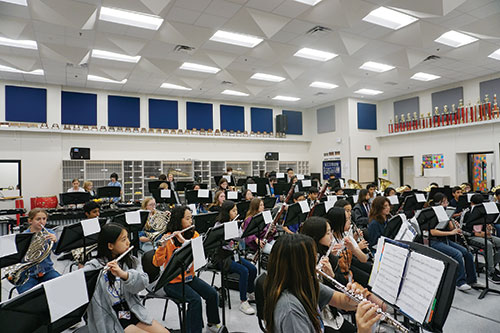
Structure of Rehearsals
Our rehearsals this fall are different than in a regular year. The warm-up is pretty short so we can get to all the music. Right now, I’m hoping to play eleven pieces, which is a lot for a middle school band. In a normal year, I would spend 15-20 minutes per rehearsal on such fundamental skills as listening, balancing, note starts, note releases, getting their tongues and fingers working, scales, and then fun music and sightreading. Now, we spend about seven minutes on the warm-up and then go straight to the music.
Lessons from COVID
My school was 60% virtual during the pandemic, and that was hard for me. About 6 to 10 kids in my band who are going to Midwest were full virtual students as beginners. At my campus, I had a lot of problems getting students to log on and do any work. I had to make it more engaging and fun, so I used Blooket to develop quiz games to help them. Every time we logged on, they would tell me a fun fact about themselves just to make it fun and different from their other classes. Moving to where we are now, I still use Blooket and those kinds of things because kids are now learning more from TikTok and YouTube, so I know they like videos and use them to teach theory.
My First Visit to Midwest
My first time was with the Hebron band in 2010, and I was just shocked and amazed at the composers and the audience. It was eye-opening and such a positive experience. Those kids enjoyed being thought of as something special. It was thrilling. In 2016 when we had the rehearsal where the composers participated, I was so scared, but it was a great experience for the students.
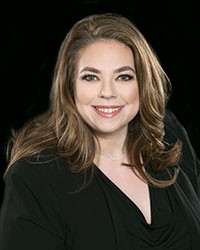
Cedar Falls, Iowa
Directed by Kyle Engelhardt
Cedar Falls
Cedar Falls is a small college town with about 36,000 residents. We have one high school for grades 10-12, and the junior highs cover grades 7-9. Because our ensembles turn over every three years, we rely on a phenomenal feeder system to maintain a strong foundation for the high school program. Students in the district start band in 5th grade, jazz band in 7th grade, and when they advance to high school, they contribute immediately.
Applying to Midwest
Our school has two jazz bands – I direct Jazz One, and my colleague Gerald Ramsey directs the second jazz band. I’m always looking for opportunities for students to have great experiences and to perform in different venues. When I was in high school, my dad took me to my first Midwest Clinic. He was my high school band director, and I told him during my senior year that I wanted to be a music major. He said we need to go to Midwest.
On that trip, I saw some of the best concert bands, professional bands, and wind ensembles that I had ever heard. I also heard some really cool jazz. During the car ride home, I told him that it would be fun to take a band to Midwest someday. He laughed and said it is good to dream big; I would have to work hard, but it would be a good goal. That was my first experience with Midwest.
Music continues to be a family experiernce for me. My daughter is in my band, and my father and mother will be there to watch us perform. My wife is one of our junior high band directors, and she will be there, along with our son, an 8th grade trumpet player, to keep me calm and cheer on her daughter.
I taught for five years before coming to Cedar Falls. I focused on making Jazz One grow and always aimed high with them. I thought performing at the state conference was a good goal, and in 2015, we were the sole jazz band invited to perform at the Iowa Bandmasters Association conference. That was really fun, and we did it again in 2018 and 2021. That band in 2021 turned into the recording band for Midwest. I had eleven seniors who had really worked hard, so we decided to go for it and sent in a recording for Midwest.
Preparing for Midwest
Because jazz meets outside of the school day, we normally have our first rehearsal right after marching band ends in mid-October. With the Midwest performance coming, I held a reading session in July and another in August. At those sessions, I passed out the music from the publishers I was considering. We read music for two hours and then had a pizza party. We settled into our program after hearing what the kids could do and where we needed to go. As soon as school started, we began jazz rehearsals on our regular extracurricular schedule: Monday nights from 8 to 10 and Wednesday and Friday mornings from 7 to 8.
The Midwest requires performing groups to program a wide range of ability levels and a lot of new music. I was fortunate to work with some great publishing companies to get music in advance that would be part of their fall releases. With the kids, the question was: “do you like this and do you want to work on this?” Music selection is near and dear to my heart – it’s our curriculum. I wanted to pick a wide variety of significant literature, both historical and new. I didn’t want to pick something just to meet a requirement. Students nixed a couple of ideas, but the majority of the music I had selected for them to read was either a yes or maybe. Charts in the maybe pile required reading it again to make sure we could play it.
The Midwest selected three high school jazz bands, two college bands, and one middle school group for 2022. I found selecting the Grade 1 and 2 music was the hardest because we were all vying for the same pieces. There has been a lot of really smart writing that has come out in the last three years for Grades 1 and 2. One of these, Calypso Angelical by Steve Shanley was commissioned by our 7th grade band director, Eric Lins, in 2018 and published by Iowa-based C.L. Barnhouse in 2020. It met all of the requirements, and Steve is a friend of ours. Students who were in 7th grade when this chart was commissioned are now juniors in my band. That’s a unique tie for Cedar Falls, to play a piece that they first learned as beginning jazz students at a national conference four years later.
Greatest Strengths
When people hear our band, they should hear a fundamentally sound ensemble with kids who know their roles within the group and play with characteristic tone on their instruments. I think you can say that about any of the bands in Cedar Falls. We work hard to make sure that their music sounds authentic. I have a strong jazz background from college and like to improvise and listen to jazz. When I am teaching, my horn is in my hand a lot. You have to hear jazz to play it.
Teaching Improvisation
Many of our students get their start in improv in seventh and eighth grade. Our junior high teachers do a great job of giving them space to improvise their solos instead of following the suggested written solo. Beginning improvisers start with the blues or simple melodies and learn to embellish the melodies, a process that continues in high school. The players in Jazz Two gain considerable experience soloing, and when they reach Jazz One, kids are expected to play more advanced changes and improvise at a higher level. It all comes back to sounding like you have listened to jazz before and can speak appropriately in the jazz idiom. I had ten out of seventeen students attend combo camp this summer at the University of Northern Iowa and dive deep into improv.
Pandemic Lessons
We had in-person school throughout the 2020-21 school year but used masks and bell covers. The ensembles were smaller during that period. When we came back to school that fall, we set up cameras in the balcony and streamed concerts for parents at home. The first in-person concert happened in March 2021, and there was such a feeling of euphoria having people there to listen to us again. The whole ensemble played so much better with an audience, and that’s something I will take with me from the pandemic. We can’t take our audience for granted and have to respect that they are there to hear and cheer us on. We must treat the audience with respect as partners in our musicmaking.
Rehearsal Strategies
Because the jazz program is extracurricular, I can always set up the room in advance. I ask players to come in 15 minutes early and complete an appropriate warm-up for their instrument. My bass player needs to come in and walk through some lines, make sure the bass plays in tune, plug into the tuner, and be ready to go. The lead trumpet is a whole different animal. He needs to warm up, get a buzz going, and play a couple of lips slurs and fundamental tones. Students are responsible during that 15 minutes for getting ready to rehearse.
I always start rehearsals with something that we can swing and groove on. I don’t like using group warm-ups with my jazz bands and would rather get going with something in our literature that I know works great. This gets everybody on the same page. Ideally, it’s not the highest shout section in the chart, so I don’t blow up my lead players’ faces. I might pick an easy swing chart to start before playing the hard, fast swinger that I really need to rehearse. Also, I might play a straight-eighth modern jazz tune if we are going to be working on a Latin chart soon after that, just to get the straight-eighth feel and that pulse going.
After we have played a bit and everyone is feeling good, I will use a whole-part-whole approach. We will take a chunk of a tune, and everyone will play it. Then, we work really hard within the sections to break it down, fix what needs to be fixed, and then put it back together. I will do that on every chart we play during the rehearsal.
I watch the time pretty carefully so that we start and end on time. I always want players to end the rehearsal feeling good so they can go home happy about the time they spent in jazz band. I pick a section that is going to sound good or that we just rehearsed, run it, let people solo, give it a ride, and then end the rehearsal.
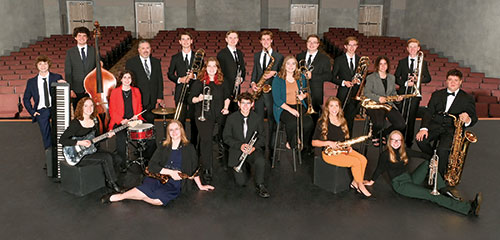
Notable Commission
One commission that I had a hand in developing is First In, Last Out by Bob Washut. It was commissioned in honor of Brett Neal a drummer from Valley High School in West Des Moines, Iowa who was killed in a car accident. Joe Turner was Brett’s band director, and Joe and I have been friends for 25 years. Joe passed away from lymphoma in April 2018, but while he was in the hospital, he talked with me and some other friends about the chart he never got written to honor his drummer. He wanted it to be a drum feature but not necessarily drums all the time because nobody likes that. He requested a feel-good tune instead of something sad, and he wanted people to be able to solo on it and feel good. Joe asked us to help make it happen, and two weeks later he passed away.
We got together with the band staff at Valley and Joe’s former teachers and commissioned the chart that summer. It was published in 2020 by iJazzMusic. It’s a beautiful chart, everything Joe wanted, which means the world to me because we went to college together, we played together, we were in each other’s weddings. I was there at the end to help Joe get one of his last wishes. It is a special chart with tons of meaning.
Mentors
Dan Peterson, my college director at Truman State, was so good about teaching the value of treating all music with respect whether it was marching, concert, jazz, or small ensemble. He reminded us that band is a community activity and you have to run a complete program that is part of your school and town. When I arrived at college, I thought jazz was all I needed to do, but Dan helped me appreciate playing in an orchestra, wind ensemble, or brass choir and made me a more well-rounded teacher. (See Dan Peterson’s Midwest stories on page 40.) Because the University of Northern Iowa is in Cedar Falls, I have learned so much from the phenomenal teachers there including Bob Washut, Chris Merz, and Mike Conrad. They all have a unique voice, they program beautifully, and it’s a joy to go to their concerts. They have been good friends and mentors.
Lessons Learned
When I first started teaching jazz, I didn’t appreciate the significant role that the rhythm section and solos play in the success of the performance. I thought as long as the winds sound good and we are in time, it will be fine. I spent way too much time back then cleaning up wind parts and not nearly enough time with soloists and the rhythm section. Now, I have worked really hard to find time in rehearsal to work on rhythm section parts and solos while still keeping the wind players engaged.
As a band director, it is so easy to say there are fifteen wind players and only four in the rhythm section, but if your rhythm section is not doing its job, nobody will want to listen to you. It is so interesting to hear old recordings of my band from when I first started and compare them to where we are now. Those early performances could have been so much better if I had paid attention to the ride cymbal groove or to the bass playing on the beat.
Keeping Jazz Band Relevant
Finding relevant and interesting music is our job. Literature has to have artistic value and importance. I look for a mix of modern and classic music. Every year I will try to play a Basie, Ellington, Mary Lou Williams, or Fletcher Henderson chart so students experience some classic swing. Exposing players to the unique challenges of those charts is important.
I also look for newer stuff and have done a couple arrangements of Snarky Puppy’s music, which is really fun and modern and different. The students are surprised and excited to play this music. We also explore a variety of multicultural music including Afro-Cuban pieces, Latin pieces, and more. Steven Feifke composes some interesting new works. He does quite a bit of commercial arranging but also really distinctive big band writing. His music is really fun, and we will be playing one of his pieces at Midwest. Looking for an appropriate balance of old and new, as well as culturally diverse composers and arrangers, keeps things fresh for students, and they just like it better. That’s what keeps them coming.
Memories from Midwest Preparation
The Midwest experience from the performer side is unique. In 1993, I was dreaming about bringing a band to perform and almost 30 years later, that dream has come true. I am so thankful for the opportunity. I have dedicated students who have worked so hard with the backing of incredible parents and administrators. The amount of work required to bring a band to Midwest is amazing. The logistics of busses and hotels and the music programming requirements make it so different from typical concert. At the same time, our concert will represent us well as a school and as a band.
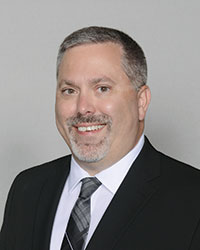
Kyle Engelhardt is in his 22nd year of teaching instrumental music and has been a faculty member at Cedar Falls High School in Iowa since 2004. At Cedar Falls High School, he conducts Jazz One and the Symphonic Band and co-directs the Tiger Marching Band. His bands have performed three times at the Iowa Bandmasters Association Conference. He was a quarterfinalist for the Grammy Music Educator Award in 2019 and earned degrees from Truman State University. His wife, Laura, directs bands at Holmes Jr. High in Cedar Falls, and they have two children.
